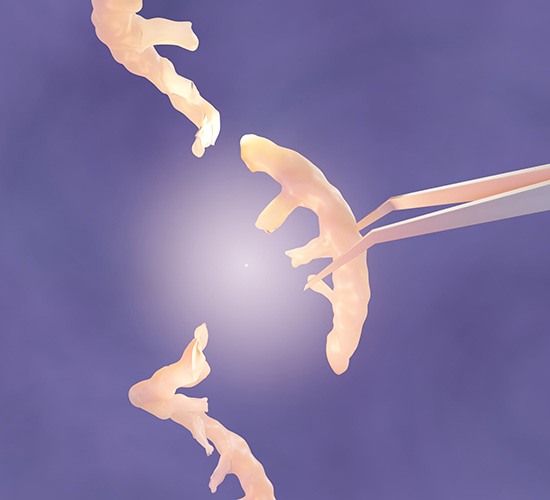From the journals: JBC
Ribosomal RNA, R-loops and the RNA exosome. Using an old drug to treat a new skin disease, Sugar-binding immune receptors. Read about papers on these topics that have been recently published in the Journal of Biological Chemistry.
Ribosomal RNA, R-loops and the RNA exosome

Many classes of RNAs are processed post-transcriptionally. For example, ribosomal RNA must be processed from its transcribed form into mature rRNA before it is incorporated into ribosomes. Key steps in this precise processing are performed by the RNA exosome, an evolutionarily conserved, essential complex comprising a number of subunits and associated with cofactors. The RNA exosome also contributes to the resolution of DNA–RNA hybrids, or R-loops, which form naturally during transcription and during DNA repair. Researchers recently showed that missense mutations in genes encoding structural subunits of the RNA exosome can lead to neurological diseases, potentially by altering interactions with cofactors that confer substrate specificity.
In their recent study published in the Journal of Biological Chemistry, Julia de Amorim and colleagues at Emory University sought to identify novel interactors of the RNA exosome. Using co-immunoprecipitation and mass spectrometry, they found cross talk between the RNA exosome subunit EXOSC3 and the RNA helicase DDX1, which is also involved in double-strand break repair. They further showed that this RNA exosome subunit and helicase interaction decreases in the presence of DNA damage and that loss of either molecule alters the formation and accumulation of R-loops. RNA-sequencing analysis showed that loss of EXOSC3 or DDX1 led to increased R-loops in areas of the genome implicated in cellular stress responses and decreased R-loops in genes involved in axon guidance.
These results suggest a role for this EXOSC3-DDX1 interaction in suppressing aberrant gene expression — the formation and degradation of R-loops in specific genes by the RNA exosome and DDX1 could explain mechanistically how missense mutations lead to neurological disease. However, as both the RNA exosome and DDX1 are ubiquitously expressed, it is unclear why disruption of this interaction would only impact specific regions within the brain. Future studies are necessary to determine whether DDX1 functions as an RNA exosome cofactor.
Using an old drug to treat a new skin disease
Ion channels in skin cells sense many tactile stimuli, including heat and pain. The TRPV3 ion channel is expressed in keratinocytes, the primary cell type in the outer layer of skin, where it opens and closes to regulate calcium conductance in response to temperature changes. Gain-of-function mutations in the gene encoding this channel have been implicated in the pathology of several skin disorders, such as hyperkeratosis, dermatitis and abnormal hair growth, which suggests that pharmacological inhibition of TRPV3 signaling holds potential for treating skin diseases.
In their recent work published in the Journal of Biological Chemistry, Yimei Xu and colleagues from Qingdao University in China screened a library of FDA-approved drugs against TRPV3 using molecular docking simulations. They found that the drug flopriopone, developed from a small molecule derived from a medicinal plant and used to treat spasms in nervous system disorders, reduced the probability of the TRPV3 channel being in the open conformation without altering its conductance when open. They also showed that topical application of flopriopone alleviated skin lesions and ear skin swelling in mice genetically altered to have skin inflammation.
These findings indicate that flopriopone is a selective inhibitor of the TRPV3 ion channel. Repurposing this drug could hold promise for treating a variety of skin disorders.
Sugar-binding immune receptors
Sialic acid-binding immunoglobulin-like lectins, or Siglecs, are a family of immune receptors that bind carbohydrate ligands containing the monosaccharide sialic acid. In recent years, researchers have focused on the Siglec receptor because sialic acid–containing glycans are overexpressed in a range of tumor cells. Siglec-7 is now a significant target of interest in cancer immunotherapy; however, scientists do not yet know the precise identity of glycan ligands that Siglec-7 binds.
Natalie Stewart and colleagues at the University of British Columbia, Vancouver in their recent article in the Journal of Biological Chemistry characterized Siglec-7 ligands in different subsets of peripheral immune cells using enzymes that cleave cell-surface glycans and liquid chromatography coupled with mass spectrometry. They determined that mucin-type glycoproteins with O-linked glycans containing a disialyl group are highly expressed on naïve T cells and are the major immune ligands that bind Siglec-7.
They also found that the biosynthesis of these glycans was regulated via a genetic circuit involving the glycosyltransferase GCNT1. Additional experiments suggested that Siglec-7 binds T-cell glycans to regulate intra-immune signaling and T-cell activity.
These results highlight the role Siglecs play not only in cancer but in priming T cells to regulate innate immunity. This could have broader implications for the design and implementation of Siglec-targeting immunotherapies.
Enjoy reading ASBMB Today?
Become a member to receive the print edition four times a year and the digital edition monthly.
Learn moreGet the latest from ASBMB Today
Enter your email address, and we’ll send you a weekly email with recent articles, interviews and more.
Latest in Science
Science highlights or most popular articles

Fueling healthier aging, connecting metabolism stress and time
Biochemist Melanie McReynolds investigates how metabolism and stress shape the aging process. Her research on NAD+, a molecule central to cellular energy, reveals how maintaining its balance could promote healthier, longer lives.

Mapping proteins, one side chain at a time
Roland Dunbrack Jr. will receive the ASBMB DeLano Award for Computational Biosciences at the ASBMB Annual Meeting, March 7–10, just outside of Washington, D.C.

Exploring the link between lipids and longevity
Meng Wang will present her work on metabolism and aging at the ASBMB Annual Meeting, March 7-10, just outside of Washington, D.C.

Defining a ‘crucial gatekeeper’ of lipid metabolism
George Carman receives the Herbert Tabor Research Award at the ASBMB Annual Meeting, March 7–10, just outside of Washington, D.C.

The science of staying strong
Muscles power every movement, but they also tell the story of aging itself. Scientists are uncovering how strength fades, why some species resist it and what lifestyle and molecular clues could help preserve muscle health for life.

Bacteriophage protein could make queso fresco safer
Researchers characterized the structure and function of PlyP100, a bacteriophage protein that shows promise as a food-safe antimicrobial for preventing Listeria monocytogenes growth in fresh cheeses.

